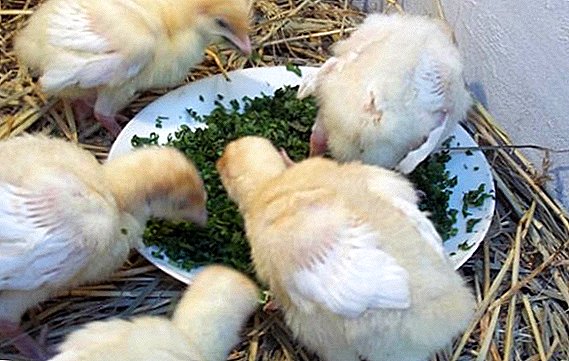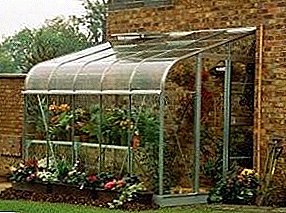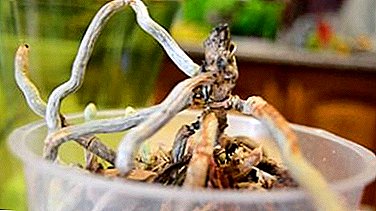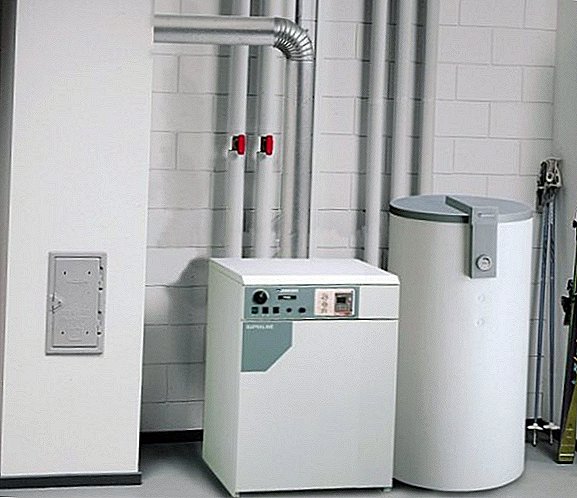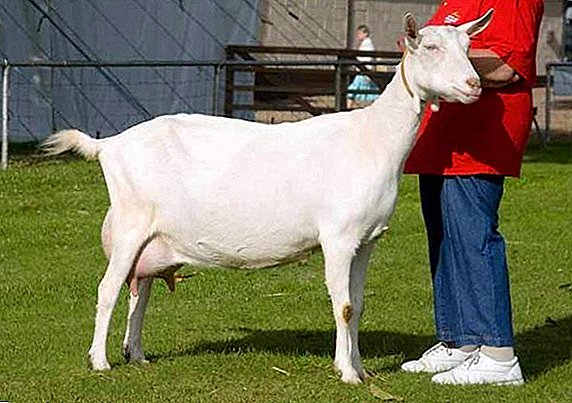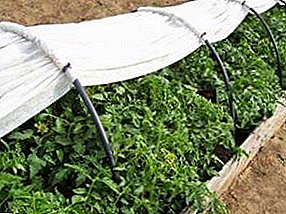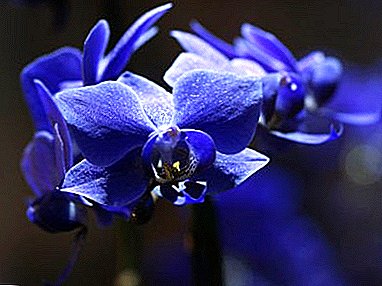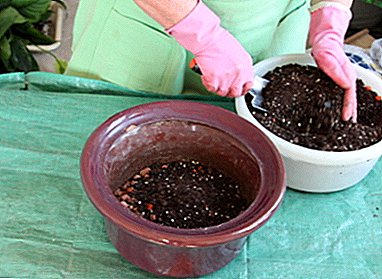
Houseplant Spathiphyllum is also called "female happiness." It is believed that the donated flower will bring well-being to the owner of the house.
So he pleased lush green and snow-white inflorescence, need care. The most important when growing is the correctly selected soil.
In the article we will consider what is better - to make it yourself or buy ready-made soil, how to pick up drainage, and also what kind of land will be wrong.
What soil does a plant live in in the wild?
In nature, it grows in the distant tropics. Prefers swampy places of South America and Malaysia. It can also be found along the banks of ponds, wet low-lying areas.
The flower loves a wet, slightly acidic, loose soil. The composition of such a natural soil includes branches, fallen leaves, dead organisms.
What is the ideal soil for “female happiness”?
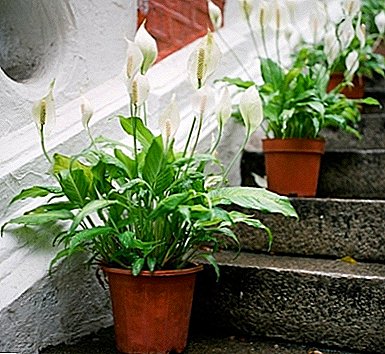 To houseplant was healthy, you need to pick up the ground. The soil nourishes the flower, so it is important to respect the proportions of the ingredients. Too wet ground will not suit him. Although in nature he likes swampy areas, there are a few other conditions in the room.
To houseplant was healthy, you need to pick up the ground. The soil nourishes the flower, so it is important to respect the proportions of the ingredients. Too wet ground will not suit him. Although in nature he likes swampy areas, there are a few other conditions in the room.
The ideal soil for the plant will be breathable, loose and moisturized. For oxygen is added to the drainage in the form of sand or pebbles. So it becomes easy. Soil should pass water well. Acidity is weak or neutral, no more than 5 - 5.5.
Soil composition:
- charcoal;
- rotten leaves, compost;
- haydite, pebble or other drainage;
- peat;
- sphagnum moss, a flower loves it;
- sand;
- fern roots;
- minerals.
What is better - self-made or purchased substrate?
 Ready soil can be bought in the store and plant the plant immediately. If time allows and there is a desire, then cook it yourself. Which is better is the choice of each.
Ready soil can be bought in the store and plant the plant immediately. If time allows and there is a desire, then cook it yourself. Which is better is the choice of each.
Advantages of the finished substrate:
- Accurate acidity.
- Save time.
- The composition is indicated.
- Available in winter.
- No pests.
The advantages of homemade:
- Low cost or free.
- The component parts are exactly known.
- Confidence in security.
- The pleasure of the process.
Land for planting and transplanting - is there a difference?
What land should be chosen for a new flower and where is it better to transplant “female happiness”? The soil for planting and transplanting should be the same. If you plant a plant in a different soil, different in composition, it may die.
When the flower is transplanted into another pot, fresh soil is poured, but of the same brand. Or cook the same.
How to make a substrate yourself?
If you want to prepare the soil yourself, you need to stock up on ingredients. This is especially convenient for those who have their own plot. Novice growers also cope with the task. The main thing is to sanitize all components. Warm up, ultraviolet lamp process, pour boiling water.
What components need to take:
- compost or humus 1 part;
- turf ground 2 parts;
- sand 1 part;
- peat 1 part;
- charcoal 0.5 parts;
- brick chips or pebbles 0.5 parts;
- sphagnum 0,25 parts.
Step by step instructions for the preparation of the mixture:

- Prepare a pot with holes in the bottom. The diameter depends on the size of the plant. Pick up so that the roots fit freely. And from them there was another 2-3 cm to the walls of the pot.
- Lay pebbles or other drainage on the bottom. Layer about 2 cm.
- The remaining components are mixed and put in another dish.
- In the pot, first put the plant on the bottom layer. Then take the soil from another vessel and fill up the free space.
- The topmost layer will again drain.
How to choose a purchase mix?
Ready-made mixtures are sold in flower shops, lawn and garden departments, and on the market. For spathiphyllum there is a special primer. But suitable for aroid, the family of which includes a flower.
However, it is worth considering, the mixture is not suitable for anthurium. It is also of the aroid family, but prefers bottom peat. And all the other kindred flowers like riding. Such peat is compacted over time, which is detrimental to the root system of spathiphyllum.
Ready-made soils from different manufacturers vary in prices and composition:
- There is a completely natural soil, using natural components, for example, “Biomaster” of Russian production for aroid ones. Price per pack 2 kg from 50 rubles. It contains sphagnum moss.
- From cheap agroswer mixes for spathiphyllum. It is completely ready for planting and transplanting. Components sterilized. For packing 2 kg from 30 rubles.
- More expensive "Vermion" for aroid. It contains a lot of nitrogen, organic matter, potassium and phosphorus. Price per pack 2.5 kg from 40 rubles.
When choosing the soil you need to navigate:
- customer reviews;
- Description of the composition (bona fide manufacturer indicates all components of the soil);
- for which plants it is intended;
- tips on how to use.
How to improve the finished mixture?
 Sometimes it is not possible to purchase a primer specifically for spathiphyllum, then in the finished mixture it is better to add the necessary components for improvement:
Sometimes it is not possible to purchase a primer specifically for spathiphyllum, then in the finished mixture it is better to add the necessary components for improvement:
- if the soil is dense, you need to add sand, vermiculite for looseness;
- To get better air to the roots, add perlite, brick chips;
- if not in the composition, add sphagnum moss, it protects the roots from rotting.
Such additives can not make a lot, no more than 10% of the total mass of the soil. Of course, you can plant the plant immediately in the finished soil. But for the sake of the health of the flower is better to use supplements.
Do I need flower feeding?
Ready soil is often poor in mineral content. therefore Spathiphyllum needs to be fed:
- The most frequent dressings are produced during flowering. Then you need to make potash and phosphate fertilizers about three times a month.
- When the flower grows, nitrogen fertilizers are applied 2 times a month.
- During dormancy, usually in winter, fertilizing is done once a month with complex fertilizer. Use dressing always after watering.
Drainage selection
The presence of drainage ensures the proper growth and development of spathiphyllum. Thanks to him, the excess water leaves, the air penetrates to the roots. The pot should also be with holes on the bottom. He put on the pallet. There is excess fluid that needs to be drained.
As drainage use:
- pebbles;
- perlite (small rocks of rock);
- expanded clay (porous safe material);
- brick chips;
- any small stones.
It is important to properly arrange these materials in the pot. Laying a layer of about 2 cm at the bottom. Too little drainage will not provide adequate ventilation to the roots.
After purchasing the material you need to hold it for 5 minutes in boiling water or just pour it. This will protect the flower from possible pests. When choosing to avoid sharp edges, so as not to damage the roots.
What land will be wrong?
- Spathiphyllum prefers moist soil, but stagnant water leads to rotting of the roots.
- Be sure to be the flow of air, that is, the ground must be loose.
- The flower loves the weak acidity of the soil.
- From overdrying the soil will save the moss, which is added to the soil mixture.
Possible problems with illiterate care and solutions
 Improperly selected soil can cause problems. From the absence of flowering to death. This can be solved by transplanting plants into the desired soil.
Improperly selected soil can cause problems. From the absence of flowering to death. This can be solved by transplanting plants into the desired soil.
Main consequences:
- Does not bloom - The reason may be in a pot or soil. To Spathiphyllum blossomed, put in a small pot. If such a measure did not help, then the ground is not properly selected. Perhaps not enough potassium or phosphorus with an excess of nitrogen. Then the leaves actively grow. So you need to add the missing fertilizer.
- Root rot - If time does not take action, the flower will die. The reason is excessive moisture. Perhaps little added drainage. Only transplanting to new soil will help, where to add activated carbon and moss. Rotten roots trimmed, dried. After transplantation, do not water for 2-3 days.
- The plant withers - the soil may be too dense. This may be due to the lack of natural disintegrators. Either the soil is outdated, eventually lost in one. A transplant will help.
- Black spots appeared - This indicates a high acidity in the soil or an excess of fertilizer. Need urgent transplant.
- Appearance of yellow spots - The leaves turn yellow, while the streaks remain green. Iron deficiency is possible. Will help spray iron chelate. It is better to transplant in a new soil.
- Parasites on the plant - most likely insects lived in the ground. Either it was poorly processed. It is necessary to transplant and cultivate the soil and drainage.
Spathiphyllum is a beautiful and unpretentious flower. But the features of care has. Follow the rules and know the preferences of the plant is not difficult. But it will save from problems and diseases. Especially flower picky mainly to the ground.


